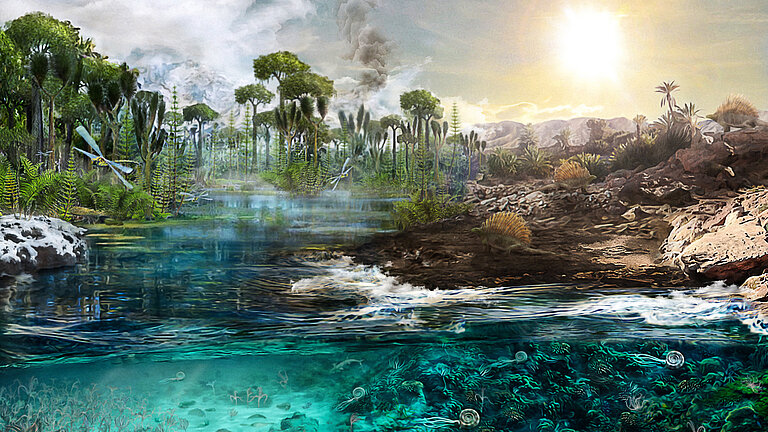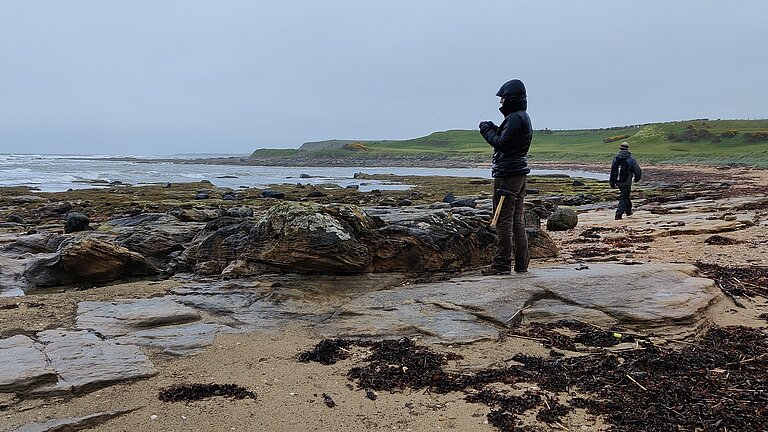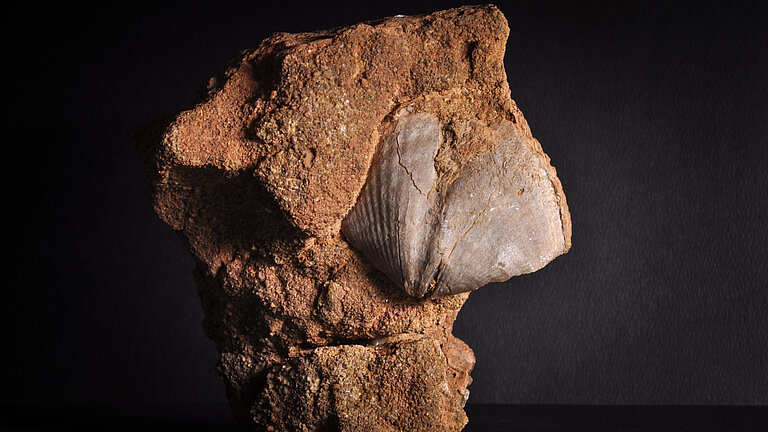Anna Niewerth
Phone: +49 (0) 431 600 2812
E-Mail: aniewerth(at)geomar.de
Cause of one of the largest climate shifts detected
International study sheds light on the role of CO2 in the Late Palaeozoic Ice Age
CO₂ is the Earth's most important greenhouse gas: it absorbs heat, radiates a large amount of it back to Earth and thus influences the global climate. While its role in recent climate change is well established, reconstructing CO₂ levels from Earth's deeper geological past has long been a challenge, leaving gaps in understanding how climate transitions between cooler and warmer states.
An international research team led by Dr Hana Jurikova from the University of St Andrews and nine other organisations, including the GEOMAR Helmholtz Centre for Ocean Research Kiel, has now reconstructed the atmospheric CO₂ content during the Carboniferous and Permian periods between 335 and 265 million years ago. Using geochemical signatures from ancient fossils, the researchers present a record of atmospheric CO₂ levels as Earth transitioned into and out of the Late Palaeozoic Ice Age. The results have now been published in the scientific journal Nature Geoscience.
Past atmospheric CO₂ levels unlocked through geochemical signatures
The research team analyzed isotopic signatures in fossilized brachiopod shells, clam-like organisms that serve as natural archives of ancient ocean conditions. ‘The chemical composition of these shells reflects the state of the oceans at the time of their formation,’ explains Dr Jurikova, Senior Researcher at the University of St Andrews and leader of the study. ‘By analyzing boron isotopes, we can estimate atmospheric CO₂ levels. Strontium isotopes reveal the fossils' age, while carbon and oxygen isotopes provide insights into CO₂ source and climate. Together, these techniques allow us to accurately reconstruct Earth's ancient CO₂ levels and understand the factors driving their changes,’ says Hana Jurikova. She previously completed her PhD at GEOMAR, where she also carried out the first geochemical measurements for the study.
CO₂ plays a central role in climate transitions
Using this methodology, the researchers found that during the Carboniferous period, atmospheric CO₂ levels fell to critically low levels, causing an extensive ice age that lasted tens of millions of years. Then, around 294 million years ago, during the Early Permian, volcanic activity caused CO₂ levels to rise, causing the Earth to warm and the ice sheets to melt. ‘The beginning and the end of the Late Palaeozoic Ice Age was one of the most important climate transitions in Earth's history, shaping the evolution of modern environments and life on our planet. We now have evidence that atmospheric CO₂ was an important driver of this change,’ says Prof Dr Anton Eisenhauer, co-author and Professor of Marine Environmental Geochemistry at GEOMAR. ‘Although the time scales of geological climate transitions differ significantly from today's anthropogenic climate changes, the principle remains the same - rising CO₂ levels drive warming and sea level rise,’ adds Dr Marcus Gutjahr, Marine Biogeochemist at GEOMAR and co-author of the study.
Reconstructing atmospheric CO₂ concentrations from hundreds of millions of years ago remains a challenge, as there are few well-preserved geological archives. The new results make an important contribution to understanding the long-term evolution of atmospheric CO₂ in geological history. However, further work is needed and gaps remain to be closed before the record of Earth’s CO₂ history can be considered complete.
Original Publication:
Jurikova, H., Garbelli, C., Whiteford, R., Reeves, T., Laker, G. M., Liebetrau, V., Gutjahr, M., Eisenhauer, A., Savickaite, K., Leng, M. J., Iurino, D.A., Viaretti, M., Tomašových, A., Zhang, Y., Wang, Shi, G. R., Shen, S., Rae, J. W. B., Angiolini, L. (2025). Rapid rise in atmospheric CO2 marked the end of the Late Palaeozoic Ice Age. Nature Geoscience.
DOI: 10.1038/s41561-024-01610-2
https://www.nature.com/articles/s41561-024-01610-2
Correction: Due to incorrect wording, we have replaced the sentence 'Using geochemical signatures from ancient fossils, the researchers present a 80-million-year record of atmospheric CO₂ levels as Earth transitioned into and out of its penultimate ice age' with the following: 'Using geochemical signatures from ancient fossils, the researchers present a record of atmospheric CO₂ levels as Earth transitioned into and out of the Late Palaeozoic Ice Age'.

Scientific illustration of the Late Palaeozoic Ice Age. A relatively rapid increase in atmospheric carbon dioxide (CO2) concentration about 294 million years ago freed the Earth from its penultimate icehouse (left) and initiated the transition to a warmer and drier climate in the Early Permian (right). The illustration is based on previously published literature and the results of the conducted study. Illustration: Dawid Adam Iurino, University of Milano for Jurikova et al. (2025)

Fieldwork in Scotland. Fossils from the late Palaeozoic Ice Age are preserved in the Carboniferous rocks along the south-eastern coast of Scotland. Photo: Hana Jurikova, University of St Andrews

Brachiopod fossil specimen. Photo: Ruben Marchesi


